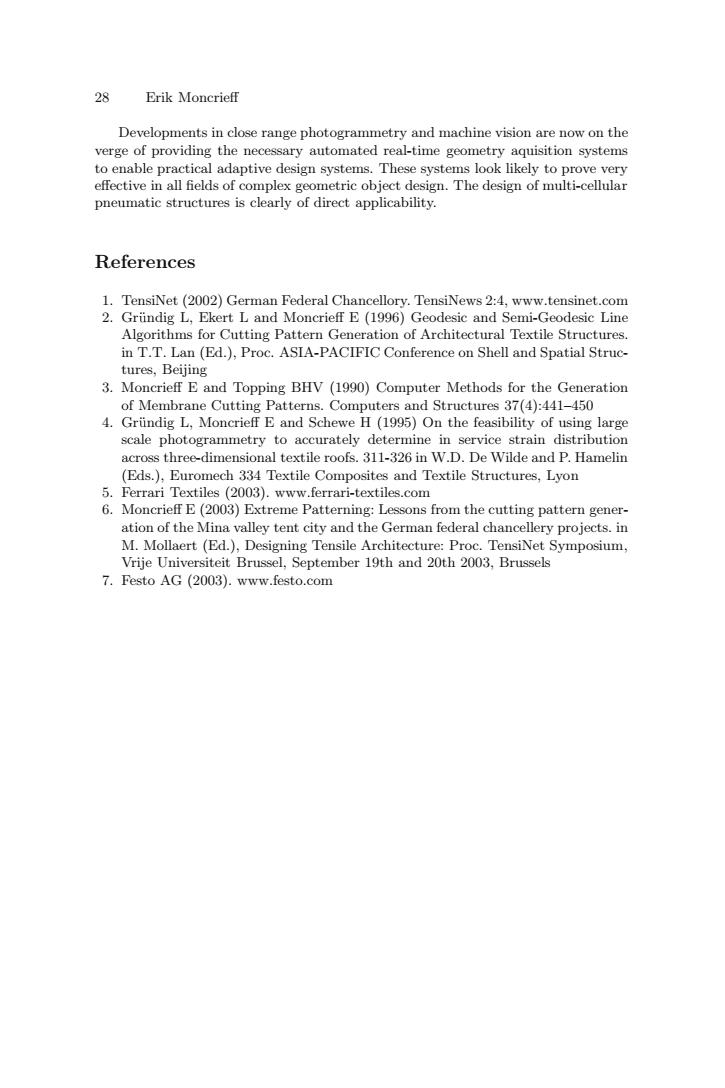正在加载图片...

28 Erik Moncrieff Developments in close range photogrammetry and machine vision are now on the verge of providing the necessary automated real-time geometry aquisition systems to enable practical adaptive design systems.These systems look likely to prove very effective in all fields of complex geometric object design.The design of multi-cellular pneumatic structures is clearly of direct applicability. References 1.TensiNet (2002)German Federal Chancellory.TensiNews 2:4,www.tensinet.com 2.Griindig L,Ekert L and Moncrieff E(1996)Geodesic and Semi-Geodesic Line Algorithms for Cutting Pattern Generation of Architectural Textile Structures. in T.T.Lan (Ed.),Proc.ASIA-PACIFIC Conference on Shell and Spatial Struc- tures,Beijing 3.Moncrieff E and Topping BHV (1990)Computer Methods for the Generation of Membrane Cutting Patterns.Computers and Structures 37(4):441-450 4.Griindig L,Moncrieff E and Schewe H(1995)On the feasibility of using large scale photogrammetry to accurately determine in service strain distribution across three-dimensional textile roofs.311-326 in W.D.De Wilde and P.Hamelin (Eds.),Euromech 334 Textile Composites and Textile Structures,Lyon 5.Ferrari Textiles (2003).www.ferrari-textiles.com 6.Moncrieff E(2003)Extreme Patterning:Lessons from the cutting pattern gener- ation of the Mina valley tent city and the German federal chancellery projects.in M.Mollaert (Ed.),Designing Tensile Architecture:Proc.TensiNet Symposium, Vrije Universiteit Brussel,September 19th and 20th 2003,Brussels 7.Festo AG (2003).www.festo.com28 Erik Moncrieff Developments in close range photogrammetry and machine vision are now on the verge of providing the necessary automated real-time geometry aquisition systems to enable practical adaptive design systems. These systems look likely to prove very effective in all fields of complex geometric object design. The design of multi-cellular pneumatic structures is clearly of direct applicability. References 1. TensiNet (2002) German Federal Chancellory. TensiNews 2:4, www.tensinet.com 2. Grundig L, Ekert L and Moncrieff E (1996) Geodesic and Semi-Geodesic Line ¨ Algorithms for Cutting Pattern Generation of Architectural Textile Structures. in T.T. Lan (Ed.), Proc. ASIA-PACIFIC Conference on Shell and Spatial Structures, Beijing 3. Moncrieff E and Topping BHV (1990) Computer Methods for the Generation of Membrane Cutting Patterns. Computers and Structures 37(4):441–450 4. Grundig L, Moncrieff E and Schewe H (1995) On the feasibility of using large ¨ scale photogrammetry to accurately determine in service strain distribution across three-dimensional textile roofs. 311-326 in W.D. De Wilde and P. Hamelin (Eds.), Euromech 334 Textile Composites and Textile Structures, Lyon 5. Ferrari Textiles (2003). www.ferrari-textiles.com 6. Moncrieff E (2003) Extreme Patterning: Lessons from the cutting pattern generation of the Mina valley tent city and the German federal chancellery projects. in M. Mollaert (Ed.), Designing Tensile Architecture: Proc. TensiNet Symposium, Vrije Universiteit Brussel, September 19th and 20th 2003, Brussels 7. Festo AG (2003). www.festo.com